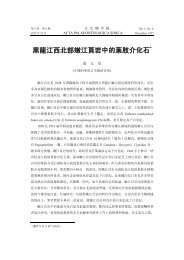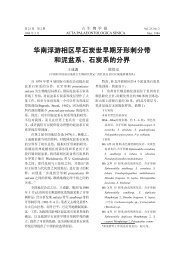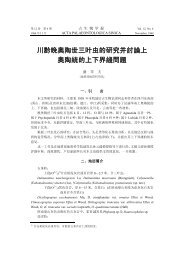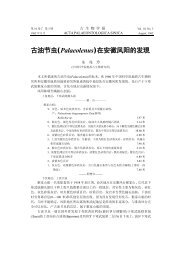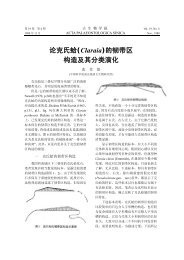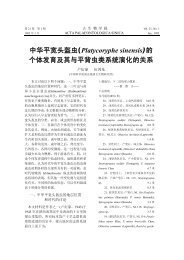ephedroids from the Early Cretaceous Yixian Formation in Liaoning ...
ephedroids from the Early Cretaceous Yixian Formation in Liaoning ...
ephedroids from the Early Cretaceous Yixian Formation in Liaoning ...
Create successful ePaper yourself
Turn your PDF publications into a flip-book with our unique Google optimized e-Paper software.
256 C. Ryd<strong>in</strong> et al.: <strong>Cretaceous</strong> <strong>ephedroids</strong> <strong>from</strong> Ch<strong>in</strong>a<br />
Fig. 21. Reconstruction of Liaoxia chenii, Cao et<br />
S.Q. Wu (emerd. Ryd<strong>in</strong>, S.Q. Wu et Friis) based on<br />
<strong>the</strong> holotype (PB17800) and <strong>the</strong> new specimens<br />
(PB20717–PB20718). Draw<strong>in</strong>g by Pollyanna von<br />
Knorr<strong>in</strong>g. Scale bar = 1 cm<br />
The cones of L. acutiformis and L. changii<br />
conta<strong>in</strong> more bracts (6–12 <strong>in</strong> <strong>the</strong> former, 6–10<br />
<strong>in</strong> <strong>the</strong> latter), but each bract is smaller and has<br />
a less dist<strong>in</strong>ctly po<strong>in</strong>ted, acute apex. In L.<br />
elongata <strong>the</strong> cones have c. 10 pairs of po<strong>in</strong>ted,<br />
narrowly ovate bracts. Several cones of Liaoxia<br />
robusta have approximately 4 pairs of<br />
cone bracts but <strong>the</strong>re are also larger cones with<br />
up to 10 bract pairs. The cones of L. longibractea<br />
consist of only 1–2 pairs of bracts,<br />
which are very long and conspicuous with <strong>the</strong>ir<br />
extended, narrow apex. They are unique<br />
among ephedroid plants, we have not seen<br />
anyth<strong>in</strong>g similar <strong>in</strong> any liv<strong>in</strong>g or fossil species.<br />
The cones of extant Ephedra are compound,<br />
consist<strong>in</strong>g of cone bracts and seeds<br />
with extra-<strong>in</strong>tegumentary structures of bract<br />
(leaf) orig<strong>in</strong> (Pearson 1929, Crane 1985, Takaso<br />
1985, Pedersen et al. 1989, Yang 2001,<br />
2004). Our <strong>in</strong>terpretation is that <strong>the</strong> cones of<br />
Liaoxia are also compound with <strong>the</strong> same<br />
structural arrangement as those of Ephedra,<br />
but <strong>the</strong> preservation of <strong>the</strong> material prevents<br />
unambiguous conclusions. Ephedra cones are<br />
generally composed of 2–8 pairs of bracts,<br />
sometimes more. This is <strong>in</strong> agreement with <strong>the</strong><br />
condition <strong>in</strong> <strong>the</strong> fossil species, even though <strong>the</strong><br />
large specimen of L. elongata has more bracts<br />
than usually seen <strong>in</strong> extant Ephedra. Many<br />
extant species have obovate to rounded cone<br />
bracts with an obtuse or rounded apex, but<br />
ovate bracts with a po<strong>in</strong>ted apex also occur <strong>in</strong><br />
some species.<br />
Seeds. Seeds are preserved as compressions<br />
or impressions <strong>in</strong> several of <strong>the</strong> fossils, even<br />
though no anatomical details are preserved.<br />
Like extant Ephedra, Liaoxia chenii has seeds<br />
only <strong>in</strong> <strong>the</strong> axil of distal bract. The cone bracts<br />
are delicate and were probably membranous,<br />
not fleshy. They are often fully reflexed, and<br />
several cones seem to lack seeds, <strong>in</strong>dicat<strong>in</strong>g<br />
w<strong>in</strong>d dispersal and preservation at a late stage<br />
<strong>in</strong> <strong>the</strong> reproduction phase. Delicate cone bracts<br />
with two ve<strong>in</strong>s that become reflexed at seed<br />
maturity can for <strong>in</strong>stance be seen <strong>in</strong> <strong>the</strong><br />
African species Ephedra alata.<br />
Contrary to <strong>the</strong> cones of Liaoxia chenii and<br />
extant Ephedra, <strong>the</strong> cones of L. changii, L.<br />
robusta and L. longibractea appear to have a<br />
seed <strong>in</strong> <strong>the</strong> axil of most bracts, also <strong>in</strong> proximal<br />
part of <strong>the</strong> cones. This is <strong>in</strong>terest<strong>in</strong>g as it differs<br />
significantly <strong>from</strong> Ephedra, which has seeds<br />
ma<strong>in</strong>ly <strong>in</strong> a distal position, but is more similar<br />
to Welwitschia where seeds also occur proximally<br />
<strong>in</strong> <strong>the</strong> cone. This is conceivably an<br />
ancestral state present <strong>in</strong> some of <strong>the</strong> <strong>Cretaceous</strong><br />
fossils and reta<strong>in</strong>ed <strong>in</strong> Welwitschia, (but<br />
see also <strong>the</strong> discussion below on <strong>the</strong> dist<strong>in</strong>ction<br />
between ephedroid and welwitschioid fossils).<br />
In Liaoxia chenii and L. changii, <strong>the</strong> seeds<br />
are ovoid to elliptic and small. In Liaoxia<br />
robusta, and L. longibractea <strong>the</strong>y are rounded




